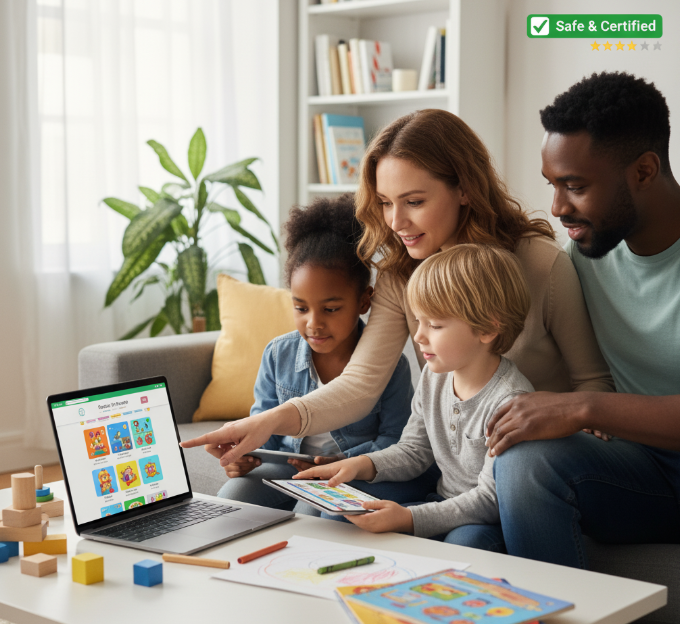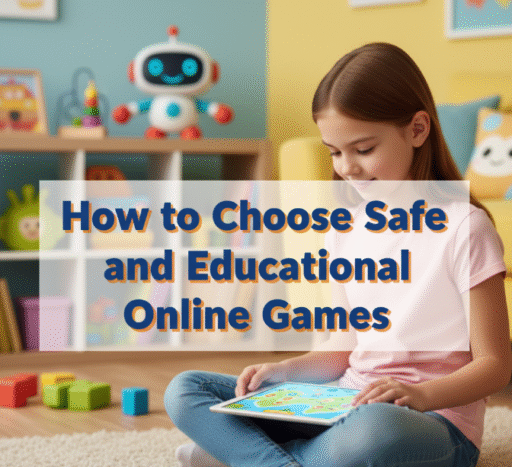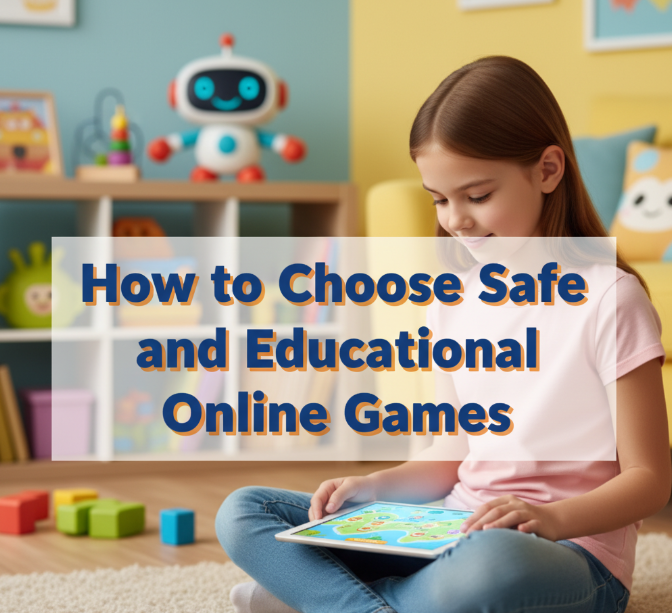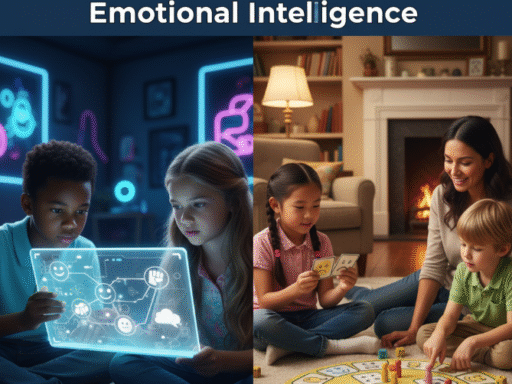Introduction
Online games are everywhere. Kids, teens, and even adults spend hours exploring digital adventures, solving puzzles, and playing multiplayer challenges. While gaming can be fun and exciting, not every game is safe or educational. Some may expose children to harmful content, while others waste valuable time without offering real learning opportunities.
That’s why parents, teachers, and even students themselves need to know how to choose safe and educational online games. The right games can boost creativity, problem-solving skills, memory, teamwork, and even school performance. But making the right choice requires careful attention to age ratings, security, educational value, and screen time balance.
This guide will walk you through step by step—helping you pick games that are fun, safe, and truly beneficial for learning.
Why Online Games Can Be More Than Just Entertainment
Before choosing a game, it’s important to understand that not all games are bad. In fact, the right ones can bring several benefits:
-
Boosts critical thinking – Puzzle and strategy games make players think logically.
-
Improves focus and memory – Memory-based and pattern-recognition games help concentration.
-
Encourages teamwork – Multiplayer games can build communication and leadership skills.
-
Enhances creativity – Sandbox and building games let kids design, plan, and create.
-
Introduces real-world knowledge – Math, science, history, and geography-based games make learning interactive.
However, the opposite is also true—violent or unsafe games can cause stress, encourage negative behavior, or expose kids to strangers online.
Step 1: Check the Game’s Age Rating
One of the easiest ways to know whether a game is safe for a child is by checking its age rating. Organizations like ESRB (Entertainment Software Rating Board) and PEGI (Pan European Game Information) provide trusted ratings.
Common Age Ratings (Simplified for Parents):
| Rating | Meaning | Example Games |
|---|---|---|
| E (Everyone) | Suitable for all ages, no harmful content | Educational puzzles, word games |
| E10+ | Ages 10 and above, may include mild cartoon violence | Minecraft, Lego Games |
| T (Teen) | Ages 13+, contains mild violence or suggestive themes | Fortnite, Roblox (with guidance) |
| M (Mature) | Ages 17+, may include violence, drugs, or explicit content | GTA, Call of Duty (not for kids) |
✅ Tip: Stick to E and E10+ for kids. Teen-rated games may be okay under supervision, but avoid mature games for children.
Step 2: Look at the Learning Value
Not all “educational games” are equally beneficial. Some only repeat basic drills, while others engage kids in deeper problem-solving.
Types of Educational Online Games:
-
Puzzle Games – Improve logic and problem-solving (e.g., Sudoku, Brain Age).
-
Math & Science Games – Make learning fun with interactive quizzes.
-
Language & Word Games – Build vocabulary and reading skills (e.g., Scrabble online).
-
History & Geography Games – Teach about different cultures and places.
-
Creativity & Building Games – Encourage imagination (e.g., Minecraft Education Edition).
👉 A good educational game should balance fun with learning. If it feels like homework, kids will lose interest quickly.
Step 3: Check Safety and Privacy
Online safety is just as important as learning. Many games now connect players worldwide, which can sometimes expose kids to strangers or inappropriate content.
Safety Checklist Before Choosing a Game:
-
Does it require chat? If yes, make sure there are parental controls.
-
Does it collect personal data? Avoid games that ask for unnecessary information.
-
Is it free or paid? Free games often include ads that may not be child-friendly.
-
Does it include in-app purchases? Kids can accidentally spend real money.
-
Can you play offline? Offline modes are usually safer for younger children.
🔒 Parental Tip: Enable parental controls on the device and restrict access to online chat if the child is too young.
Step 4: Balance Fun and Learning
Kids play games for fun, not just to learn. The trick is finding games that teach through play.
For example:
-
Math Blaster makes math fun through space adventures.
-
Minecraft Education Edition lets kids build while learning about history, science, and coding.
-
Prodigy Math uses role-playing battles while improving math skills.
A good balance makes sure kids want to keep playing, while parents know they’re gaining skills.
Step 5: Read Reviews and Do Research
Before downloading a game, take five minutes to:
-
Read parent and teacher reviews on sites like Common Sense Media.
-
Watch gameplay videos on YouTube to see what the game looks like.
-
Check app store ratings for feedback from other players.
-
Join parenting forums for real-life recommendations.
💡 Sometimes, a game may look educational in advertisements but contain hidden dangers like unsafe chat rooms or violent mini-games. Reviews help reveal the truth.
Step 6: Test the Game Yourself
The best way to decide is to play the game yourself for at least 10–15 minutes.
-
Does it encourage problem-solving?
-
Does it use teamwork or competition?
-
Is there violence or unsafe interaction?
-
Does it keep the child engaged without frustration?
By trying it first, you’ll know if it’s safe and suitable before allowing your child to spend hours on it.
Step 7: Set Screen Time Rules
Even the best educational game can become harmful if played too much.
Healthy Screen Time Guide (By Age):
| Age Group | Recommended Daily Screen Time | Example Activities |
|---|---|---|
| 5–7 years | 1 hour | Simple puzzle or math games |
| 8–12 years | 1–2 hours | Educational adventure or creative games |
| 13–18 years | 2–3 hours | Strategy, coding, or multiplayer educational games |
🎯 Balance is key: Encourage breaks, outdoor play, and real-life learning alongside gaming.
Step 8: Involve Kids in the Choice
Instead of forcing a game, let kids participate in the decision. Show them safe, age-appropriate options and let them choose. This builds:
-
Responsibility – They learn to pick safe options.
-
Engagement – They feel excited about the game.
-
Trust – Kids see that parents respect their choices.

How to Choose Safe and Educational Online Games
Safe and Educational Online Games: Recommended List
Here are some well-known, parent-approved online games that are safe and fun:
Top Picks for Kids (Ages 6–12):
-
Prodigy Math Game – Makes math an adventure.
-
National Geographic Kids Games – Teaches geography, animals, and science.
-
PBS Kids Games – Based on popular educational shows.
-
LightBot – Introduces coding basics.
-
Toca Boca Series – Creative role-play without ads or unsafe chat.
For Teens (Ages 13+ with supervision):
-
Minecraft Education Edition – Combines creativity with STEM learning.
-
Civilization VI – Teaches history, strategy, and resource management.
-
Kahoot! Quizzes – Fun multiplayer learning quizzes.
-
Duolingo Game Challenges – Helps with learning new languages.
Quick Comparison: Safe vs Unsafe Online Games
| Feature | Safe & Educational Games | Unsafe Games |
|---|---|---|
| Age Rating | E or E10+ | Teen or Mature |
| Content | Problem-solving, creativity, knowledge | Violence, gambling, explicit content |
| Privacy | Minimal data collection | Requests personal details |
| Ads & Purchases | Limited or none | Excessive in-app purchases |
| Multiplayer | Safe, moderated chat | Open chat with strangers |
Infographic: Smart Rules for Choosing Online Games
(Imagine a simple infographic with icons showing the following 5 steps)
-
Check the Rating 🕹️
-
Review Safety & Privacy 🔒
-
Look for Learning Value 📘
-
Test Before Approving ✅
-
Limit Screen Time ⏳
Conclusion
Online games don’t have to be mindless entertainment—they can be powerful tools for learning, creativity, and problem-solving. But parents and kids must choose wisely. By checking age ratings, reviewing educational value, ensuring safety and privacy, and setting healthy limits, families can turn gaming into a positive part of daily life.
The next time you search for a new game, remember: the best ones are safe, fun, and educational. With the right choices, online games can shape brighter, smarter, and safer digital experiences for children everywhere.




